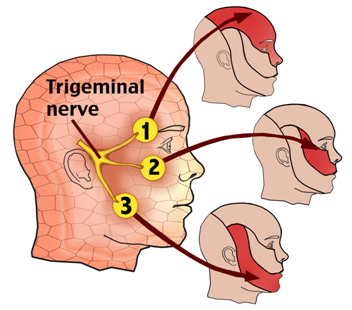Trigeminal Neuralgia Causes, Symptoms, Diagnosis and Treatment

What is Trigeminal Neuralgia?
Trigeminal Neuralgia (TN) is a chronic pain condition that affects the trigeminal or 5th cranial nerve, one of the most widely distributed nerves in the head. TN is a form of neuropathic pain (pain associated with nerve injury or nerve lesion.) The typical or “classic” form of the disorder (called “Type 1” or TN1) causes extreme, sporadic, sudden burning or shock-like facial pain that lasts anywhere from a few seconds to as long as two minutes per episode. These attacks can occur in quick succession, in volleys lasting as long as two hours. The “atypical” form of the disorder (called “Type 2” or TN2), is characterized by constant aching, burning, stabbing pain of somewhat lower intensity than Type 1. Both forms of pain may occur in the same person, sometimes at the same time. The intensity of pain can be physically and mentally incapacitating.
Causes of Trigeminal Neuralgia
Trigeminal neuralgia can occur as a result of aging, or it can be related to multiple sclerosis or a similar disorder that damages the myelin sheath protecting certain nerves. Less commonly, trigeminal neuralgia can be caused by a tumor compressing the trigeminal nerve.
Some people may experience trigeminal neuralgia due to a brain lesion or other abnormalities. In other cases, surgical injuries, stroke or facial trauma may be responsible for trigeminal neuralgia.
Triggers
A variety of triggers may set off the pain of trigeminal neuralgia, including:
- Shaving
- Touching your face
- Eating
- Drinking
- Brushing your teeth
- Talking
- Putting on makeup
- Encountering a breeze
- Smiling
- Washing your face
Symptoms of Trigeminal Neuralgia
- Brief periods of stabbing or shooting pain.
- The pain is triggered by things such as brushing your teeth, washing your face, shaving, or putting on makeup. Even a light breeze against your face might set off your pain.
- It lasts a few seconds to several minutes.
- The attacks happen several times a day or a week, followed by periods during which you have none at all. These pain-free periods are known as remission.
- The pain affects only one side of the face.
- The attacks happen more often over time, and the pain is worse.
- Pain mostly felt on cheek, jaw, teeth, gums, and lips. The eyes and forehead are affected less often.
Diagnosis of Trigeminal Neuralgia
Trigeminal Neuralgia can be diagnosed, mainly based on the description of the pain, including:
- Type. Pain related to trigeminal neuralgia is sudden, shock-like and brief.
- Location. The parts of your face that are affected by pain will tell your doctor if the trigeminal nerve is involved.
- Triggers. Trigeminal neuralgia-related pain usually is brought on by light stimulation of your cheeks, such as from eating, talking or even encountering a cool breeze.
Many tests to diagnose trigeminal neuralgia and determine underlying causes for the condition, including:
- A neurological examination.
- Magnetic resonance imaging (MRI)
Treatment of Trigeminal Neuralgia
Medication
- Anti-seizure medications
- Muscle relaxants
- Tricycle antidepressants.
Surgery
Common surgical procedures used to treat TN include:
- Glycerol Injections
- Stereotactic Radio surgery
- Radiofrequency Thermal Lesioning
- Gamma-Knife Radio surgery
- Microvascular Decompression
By : Natural Health News




